

K-WANG


Honeywell Satellite XT gas detection transmitter
Honeywell Satellite XT gas detection transmitter
Product overview
Satellite XT is an intelligent gas detection transmitter that uses a unique electrochemical sensor to detect toxic, corrosive, and flammable gases, making it a simple solution to meet all gas detection needs at any point of use. Based on the smallest and most reliable electrochemical cell technology on the market, it has the characteristics of flexibility, simplicity, and ease of application. It has two configurations to choose from, analog and digital, and can be integrated with new or existing facility control technologies. Among them, the digital version of Satellite XT is based on LonWorks ® Technology, based on LonWorks ® The life safety system built on the network platform allows users to utilize the cost-effectiveness of distributed control while maintaining the integrity and reliability required for compliant security applications.
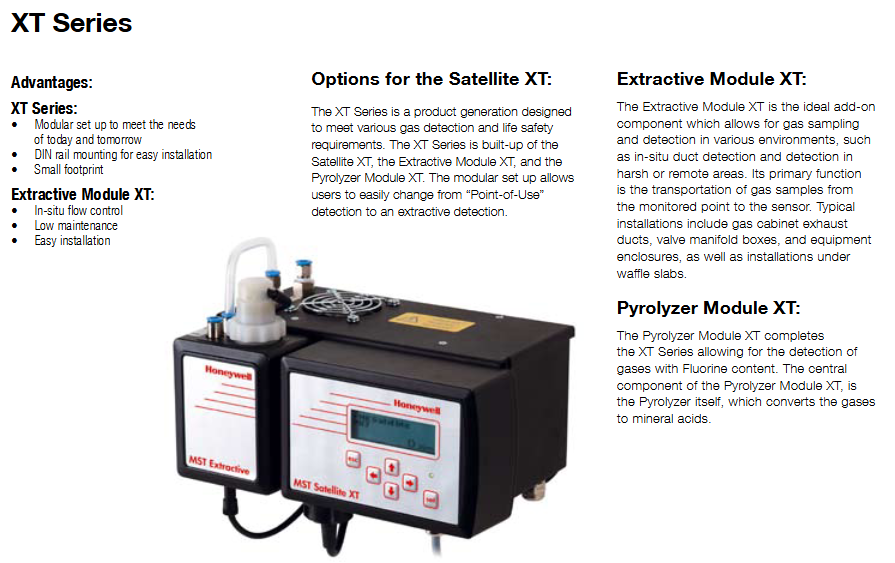
Application scenarios
Suitable for gas detection in various scenarios, including:
Gas cabinet
Valve manifold box
Equipment casing
Environmental breathing zone
Gas storage room
Original Equipment Manufacturer (OEM) equipment
Typical installation scenarios include gas cabinet exhaust pipes, valve manifold boxes, equipment enclosures, and environmental breathing zones. On site attachments provide sampling options for various environments, including in-situ pipeline testing and extractive design for harsh or remote areas.
Product advantages
Fast, reliable, and specific gas detection
Continuous real-time monitoring
Interchangeable intelligent sensor units
No need for dynamic gas calibration
General sensor head electronic device
LOW COST OF OWNERSHIP
No easily worn or replaceable moving parts
Modular settings to meet current and future needs
DIN rail installation, easy to install (advantages of XT series)
The extraction module XT has the advantages of in-situ flow control, low maintenance, and easy installation
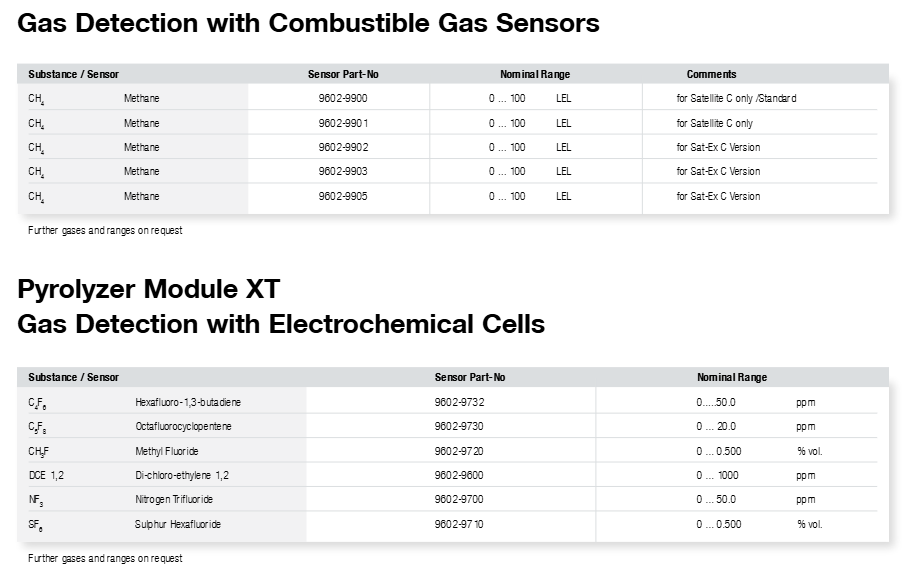
Series composition and options
The XT series is a product line designed to meet various gas detection and life safety requirements, consisting of Satellite XT, Extraction Module XT, and Pyrolysis Module XT. Modular settings allow users to easily switch from "point of use" detection to extractive detection.
Extraction module XT: an ideal add-on component that allows gas sampling and detection in various environments, such as in-situ pipeline testing and detection in harsh or remote areas. Its main function is to transfer gas samples from monitoring points to sensors.
Pyrolysis module XT: The XT series has been improved to allow for the detection of fluorine-containing gases. Its core component is the pyrolyzer, which can convert gases into inorganic acids.
Sensor Expansion: Available in three lengths: 1 meter, 2 meters, and 3 meters.
Sensor related
Electrochemical cell gas detection sensor
It covers various substances, such as arsine (AsH ∝), diborane (B ₂ H ₆), bromine (Br ₂), chlorine (Cl ₂), etc. Each substance corresponds to different sensor models, nominal ranges, and related descriptions, and more gases and ranges can be provided upon request.
Combustible gas sensor
For methane (CH ₄), there are various sensor models with nominal ranges of 0... 100 LEL, suitable for different versions of equipment.
Pyrolysis module XT electrochemical cell gas detection sensor
Including hexafluoro-1,3-butadiene (C ₄ F ₆), octafluorocyclopentene (C ₅ F ₈), etc., each substance corresponds to a specific sensor model and nominal range.
Working principle of sensors
Electrochemical sensors are all ampere type, similar to fuel cells. In order to generate current, they lack a component, which is the gas (target gas) that should be detected. The target gas diffuses through the breathable membrane into the sensor, where an electrochemical reaction occurs, producing a low current proportional to the measured gas concentration (usually read in nA/ppm).
The current is amplified into a signal and processed by electronic circuits to display real-time gas concentration. The zero current of electrochemical cells always exists and is monitored and suppressed by electronic devices.
Honeywell Analytical Instruments has created an "intelligent sensor" with a built-in PROM that programs all relevant sensor data (such as sensitivity, target gas, first calibration date, calibration data, zero current, and alarm level) onto the chip. The detector can read this data and automatically adjust the amplification factor.
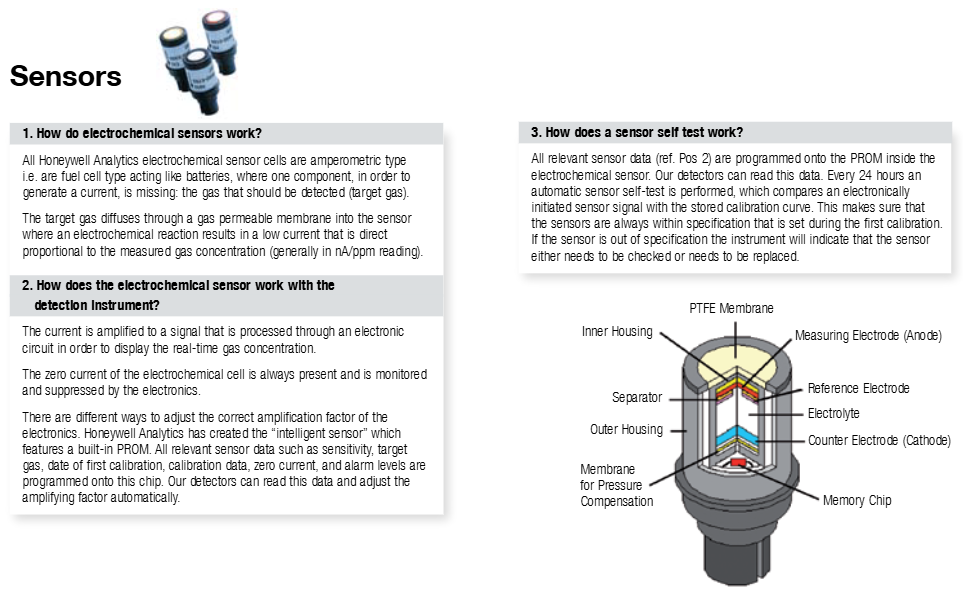
Sensor self-test
All relevant sensor data is programmed into the PROM inside the electrochemical sensor, and the detector can read this data. Perform an automatic sensor self-test every 24 hours, comparing the electronically activated sensor signal with the stored calibration curve to ensure that the sensor remains within the specifications set during the initial calibration. If the sensor exceeds the specifications, the instrument will indicate that the sensor needs to be checked or replaced.
Technical specifications
Digital version (such as Satellite XT FTT, etc.)
Power requirements: Voltage ranging from 12 to 24 VDC, maximum power consumption varies for different models, such as FTT maximum 0.6W, FTT/R maximum 1.4W, etc.
Network data transmission: 78Kb/s.
Wiring topology: Free, such as bus, star, ring, or hybrid.
Wiring: The network uses 4-wire shielded cables, and relay contacts use 6-wire shielded cables.
Relay output: 3 single pole single throw (SPST) contacts, maximum rated 250 VAC/30 VDC, 2A.
Graphic display: 122 x 32 dots with backlight.
Status LED: Green.
Keyboard: 6 touch sensitive film function keys.
Physical dimensions: 145 x 95 x 50mm (length x width x height).
Weight: Different models have different weights, such as FTT at 480g (17oz) and FTT/R at 650g (23oz).
Installation: Special installation board (provided with the instrument).
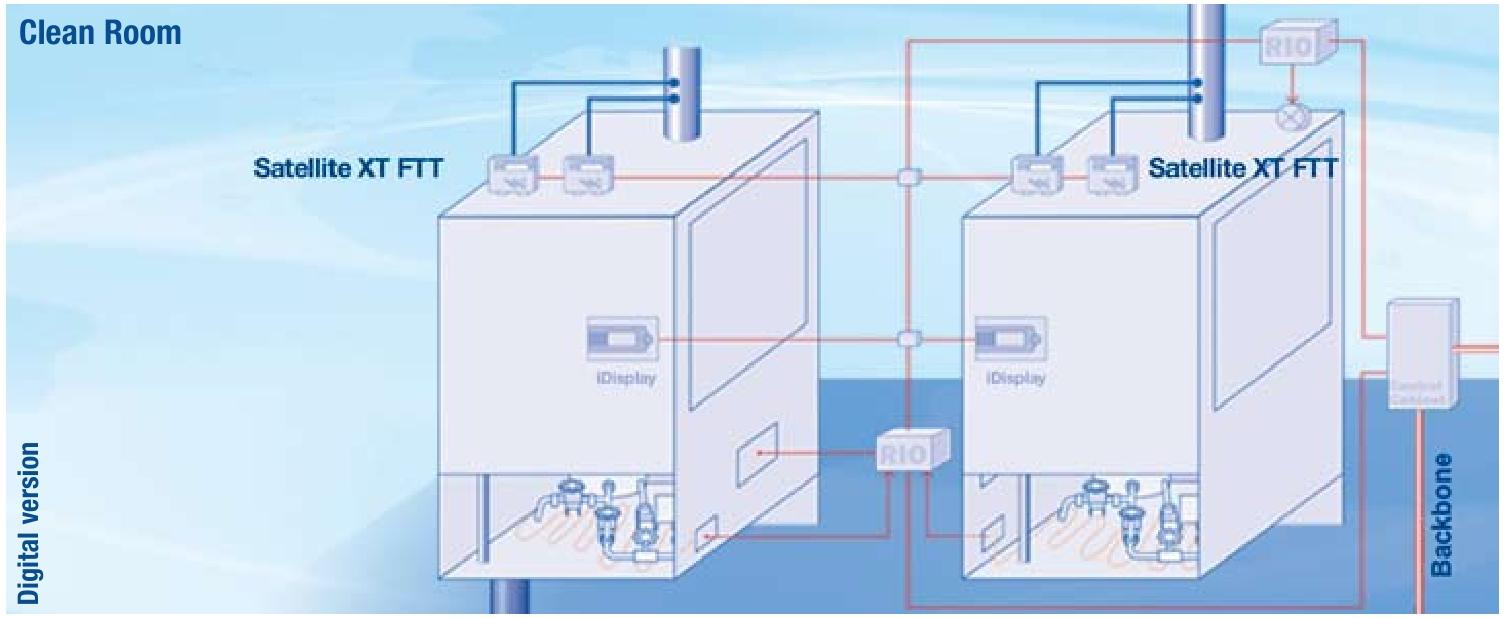
Shell protection level: IP 52 (optional IP 65).
RF interference/electromagnetic compatibility: Complies with EN 55022 and EN 50082-2 standards.
Working conditions: temperature from -20 ° C to+40 ° C, pressure from 700 to 1300hPa, humidity from 20 to 90% relative humidity.
Part number: Different models correspond to different numbers, such as FTT 9602-0400, FTT/R 9602-0405, etc.
Simulated version (Satellite XT 4-20 mA, etc.)
Power requirements: Voltage 12 to 24 VDC, maximum power consumption varies for different models, such as 4-20 mA with a maximum of 1W, 4-20 mA/R with a maximum of 1.8W, etc.
Analog signal output: The monitoring mode is 2-20mA or 4-20mA, the warning state is 2.8-4 mA 0.1Hz, the maintenance mode is 2.4-4 mA 1Hz, and the fault range is 0-2mA.
Wiring: The analog interface uses 3-wire shielded cables, and the relay contacts use 6-wire shielded cables.
Relay output: 3 single pole single throw (SPST) contacts, maximum rated 250 VAC/30 VDC, 2A.
Graphic display: 122 x 32 dots with backlight.
Status LED: Green.
Keyboard: 6 touch sensitive film function keys.
Physical dimensions: 145 x 95 x 50mm (length x width x height).
Weight: Different models have different weights, such as 480g (17oz) for 4-20 mA and 650g (23oz) for 4-20 mA/R.
Installation: Special installation board (provided with the instrument).
Shell protection level: IP 52 (optional IP 65).
Radio frequency interference/electromagnetic compatibility: Complies with standards such as EN 55011 and EN 50082-2.
Working conditions: temperature from -20 ° C to+40 ° C, pressure from 700 to 1300hPa, humidity from 20 to 90% relative humidity.
Part number: Different models correspond to different numbers, for example, 4-20 mA is 9602-0200, 4-20 mA/R is 9602-0205, etc.
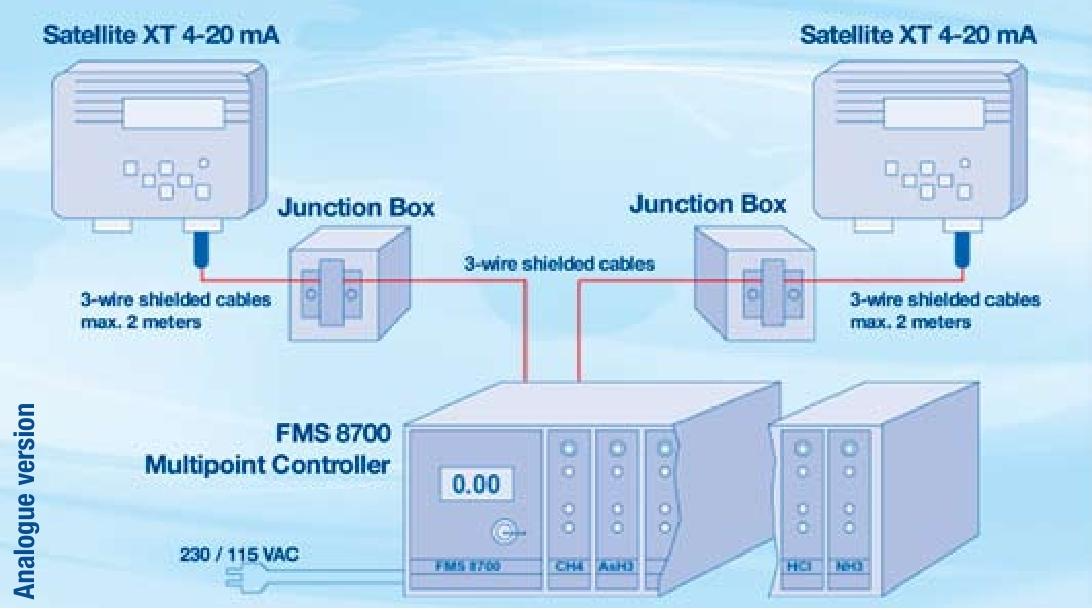
Honeywell related products and services
Range
Fixed gas monitoring: Honeywell Analytical Instruments provides a wide range of fixed gas detection solutions, suitable for various industries and applications, including commercial properties, industrial applications, semiconductor manufacturers, energy plants, and petrochemical plants. It can detect flammable, oxygen, and toxic gases (including foreign gases), with four core sensing technologies (paper tape, electrochemical cells, catalytic beads, and infrared), capable of detecting gases as low as one billionth (ppb) or volume percentage (% v/v), providing cost-effective solutions that comply with regulations, as well as customized preventive/corrective maintenance plans and extended product warranties.
Portable gas monitoring: Honeywell analytical instruments have a wide range of reliable solutions for personal protection against gas hazards, making them ideal for use in enclosed or confined spaces, including detecting flammable, oxygen, and toxic gases, single gas personal monitoring devices (worn by individuals), multi gas portable gas monitoring devices (for confined space entry and regulatory compliance), and multi gas transportable monitoring devices (for temporary protection of areas during on-site construction and maintenance activities).
Technical service
Honeywell Analytical Instruments values high-quality service and customer care, committed to providing complete and thorough customer satisfaction. The services provided include comprehensive technical support, well-equipped workshops to ensure quick repair turnover, a comprehensive network of service engineers, product usage and maintenance training, mobile calibration services, and more.
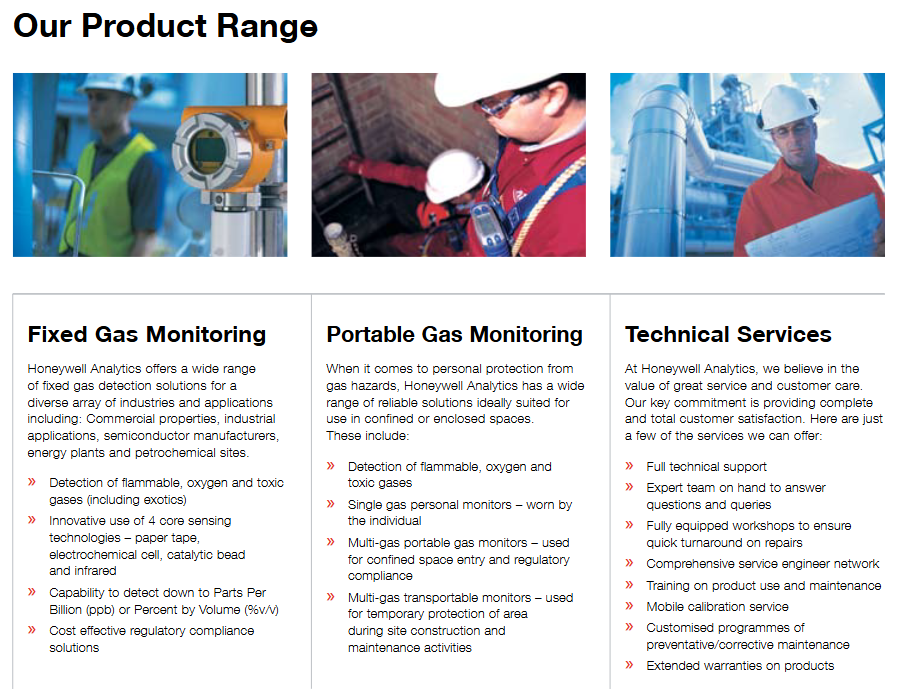
- YOKOGAWA
- Energy Access
- Renewable Integration
- Energy Subsidies
- Energy and Water
- Net zero emission
- Energy Security
- Critical Minerals
- A-B
- petroleum
- Mine scale
- Energy and Gender
- Covid-19
- man-machine
- Reliance
- ADVANCED
- SEW
- ProSoft
- WATLOW
- Kongsberg
- FANUC
- VSD
- DCS
- PLC
- Sewage treatment
- cement
- Yaskawa
- Woodward
- BOSCH Rexroth
- MOOG
- General Electric
- American NI
- Rolls-Royce
- CTI
- Honeywell
- EMERSON
- Automobile market
- xYCOM
- Motorola
- architecture
- Industrial information
- New energy
- electricity
- Construction site
- HIMA
- ABB
- Rockwell
- Schneider Modicon
- Siemens
- MAN
- GE
- TRICONEX
- Control Wave
- ALSTOM
- AMAT
- STUDER
- KONGSBERG
- MOTOROLA
- DANAHER MOTION
- Bentley
- Galil
- EATON
- MOLEX
- Triconex
- DEIF
- B&W
- ZYGO
- Aerotech
- DANFOSS
- KOLLMORGEN
- Beijer
- Endress+Hauser
- schneider
- Foxboro
- KB
- REXROTH
- YAMAHA
- Johnson
- Westinghouse
- WAGO
- TOSHIBA
- TEKTRONIX
- BENDER
- BMCM
- SMC
-
GE Hydran M2-X Enhanced Monitoring
-
ABB REG316 1mrk000809-GA Numerical Generator Protection
-
ABB RED670 1MRK004810 Line differential protection
-
GE SR750-P5-G5-S5-HI-A20-R-E Feeder protection system
-
ABB PFTL301E-1.0KN 3BSE019050R1000 PillowBlock Load cells
-
Kollmorgen S33GNNA-RNNM-00 - Brushless Servo Motor
-
Kollmorgen 6sm56-s3000-g-s3-1325 - Servo Motor
-
Kollmorgen AKM52K-CCCN2-00 - Servo Motor
-
Kollmorgen PSR3-230/75-21-202 - Power Supply
-
Kollmorgen akm24d-anc2r-00 - Servo Motor
-
Kollmorgen AKM22E-ANCNR-00 - Servo Motor
-
Kollmorgen S60300-550 - Servo Drive
-
Kollmorgen B-204-B-21 - Servomotor
-
Kollmorgen AKM21E-BNBN1-00 - Servo Motor
-
Kollmorgen TT2953-1010-B - DC Servo Motor
-
Kollmorgen pa8500 - Servo Power Supply
-
Kollmorgen BDS4A-210J-0001-207C2 - Servo Drive
-
Kollmorgen TTRB1-4234-3064-AA - DC Servo Motor
-
Kollmorgen MH-827-A-43 - Servo Motor
-
Kollmorgen AKM24D-ACBNR-OO - Servo Motor
-
Kollmorgen 00-01207-002 - Servo Disk DC Motor
-
Kollmorgen AKM21C-ANBNAB-00 - Servo Motor
-
Kollmorgen PSR3-208/50-01-003 - Power Supply
-
Kollmorgen 6SM56-S3000 - Servo Motor
-
Kollmorgen DBL3H00130-B3M-000-S40 - Servo Motor
-
Kollmorgen 6SN37L-4000 - Servo Motor
-
Kollmorgen AKM65K-ACCNR-00 - Servo motor
-
Kollmorgen 6SM56-L3000-G - Servo Motor
-
Kollmorgen AKMH43H-CCCNRE5K - Servo Motor
-
Kollmorgen PSR4/52858300 - Power Supply
-
Kollmorgen KBM-79H03-E03 - Direct Drive Rotary Motor
-
Kollmorgen AKM33E-ANCNDA00 - Servo Motor
-
Kollmorgen U9M4/9FA4T/M23 - ServoDisc DC Motor
-
Kollmorgen AKM13C-ANCNR-00 - Servo Motor
-
Kollmorgen AKM43L-ACD2CA00 - Servo Motor
-
Kollmorgen AKM54K-CCCN2-00 - Servo Motor
-
Kollmorgen M-605-B-B1-B3 - Servo Motor
-
Kollmorgen AKD-P00606-NBAN-0000 - Rotary Drive
-
Kollmorgen 6SM-37M-6.000 - Servo Motor
-
Kollmorgen A.F.031.5 - Sercos Interface Board
-
Kollmorgen 918974 5054 - Servo PWM
-
Kollmorgen U12M4 - ServoDisc DC Motor
-
Kollmorgen AKD-B00606-NBAN-0000 - Servo Drive
-
Kollmorgen MV65WKS-CE310/22PB - Servo Drive
-
Kollmorgen 65WKS-CE310/22PB - Servo Drive
-
Kollmorgen EM10-27 - Module
-
Kollmorgen S64001 - Servo Drive
-
Kollmorgen CR03200-000000 - Servo Drive
-
Kollmorgen 6SM57M-3000+G - Servo Motor
-
Kollmorgen BDS4 - Servo Drive
-
Kollmorgen AKD-P00306-NBEC-000 - Servo Drive
-
Kollmorgen AKD-B01206-NBAN-0000 - Servo Drive
-
Kollmorgen STP-57D301 - Stepper Motor
-
Kollmorgen 6SM37L-4.000 - Servo Motor
-
Kollmorgen 44-10193-001 - Circuit Board
-
Kollmorgen PRDR9SP24SHA-12 - Board
-
Kollmorgen PRD-AMPE25EA-00 - Servo Drive
-
Kollmorgen DBL3N00130-0R2-000-S40 - Servo Motor
-
Kollmorgen S406BA-SE - Servo Drive
-
Kollmorgen AKD-P00607-NBEI-0000 - Servo Drive
-
Kollmorgen AKD-P01207-NBEC-0000 - Servo Drive
-
Kollmorgen CR03550 - Servo Drive
-
Kollmorgen VSA24-0012/1804J-20-042E - Servo Drive
-
Kollmorgen N2-AKM23D-B2C-10L-5B-4-MF1-FT1E-C0 - Actuator
-
Kollmorgen 04S-M60/12-PB - Servo Drive
-
Kollmorgen H33NLHP-LNW-NS50 - Stepper Motor
-
Kollmorgen A-78771 - Interlock Board
-
Kollmorgen AKM43E-SSSSS-06 - Servo Motor
-
Kollmorgen AKD-P00607-NBEC-0000 - Servo Drive
-
Kollmorgen E21NCHT-LNN-NS-00 - Stepper Motor
-
Kollmorgen cr10704 - Servo Drive
-
Kollmorgen d101a-93-1215-001 - Motor
-
Kollmorgen BDS4A-203J-0001-EB202B21P - Servo Drive
-
Kollmorgen MCSS23-6432-002 - Connector
-
Kollmorgen AKD-P01207-NACC-D065 - Servo Drive
-
Kollmorgen CK-S200-IP-AC-TB - I/O Adapter and Connector
-
Kollmorgen CR10260 - Servo Drive
-
Kollmorgen EC3-AKM42G-C2R-70-04A-200-MP2-FC2-C0 - Actuator
-
Kollmorgen BDS5A-206-01010-205B2-030 - Servo Drive
-
Kollmorgen s2350-vts - Servo Drive
-
Kollmorgen AKM24D-ANC2DB-00 - Servo Motor
-
Kollmorgen E31NCHT-LNN-NS-01 - Stepper Motor
-
Kollmorgen PRD-0051AMPF-Y0 - Servo Board
-
Kollmorgen TB03500 - Module
-
Kollmorgen 60WKS-M240/06-PB - Servo Drive
-
Kollmorgen M21NRXC-LNN-NS-00 - Stepper Motor
-
Kollmorgen H-344H-0212 - Servo Motor
-
Kollmorgen MCSS08-3232-001 - Connector
-
Kollmorgen AKM33H-ANCNC-00 - Servo Motor
-
Kollmorgen PA-2800 - Power Supply
-
Kollmorgen MTC308C1-R1C1 - Servo Motor
-
Kollmorgen PRDR0091300Z-00 - Capacitor Board
-
Kollmorgen BDS4A-206J-0024/01502D79 - Servo Drive
-
Kollmorgen S20330-VTS - Servo Drive
-
Kollmorgen S20250-CNS - Servo Drive
-
Kollmorgen SBD2-20-1105-WO - Servo Drive Board
-
Kollmorgen M405-C-A1--E1 - Servo Motor
-
Kollmorgen PRD-PB805EDD-00 - Servo Drive
-
Kollmorgen 6SM57S-3.000-J-09-HA-IN - Servo Motor
-
Kollmorgen AKM33H-ANCNDA-00 - Servo Motor
-
Kollmorgen PCB-00030200-04 - PCB
-
Kollmorgen H22SSLB-LNN-NS-02 - Stepper Motor
-
Kollmorgen BJRL-20012-110001 - Module
-
Kollmorgen BDS4A-206J-0001404A - Servo Drive
-
Kollmorgen H-342-H-0802 - Servo Motor
-
Kollmorgen CR10561 - Servo Drive
-
Kollmorgen BDS5A-206-00010-205B2-030 - Servo Drive
-
Kollmorgen BDS5A-206-00010-207B-2-030 - Servo Drive
-
Kollmorgen mcss08-3224-001 - Connector
-
Kollmorgen M-207-B-23-B3 - Servo Motor
-
Kollmorgen PRD-0041200Z-S0 - Encoder/Resolver Card
-
Kollmorgen MH-225-G-61 - Motor
-
Kollmorgen MT308B1-T1C1 - Servo Motor
-
Kollmorgen BDS4A-240J-0001604C83 - Servo Drive
-
Kollmorgen 6SM57-S-3000 - Servo Motor
-
Kollmorgen N-T31V-15-5B-6-MF3-FT1E-C251 - Actuator
-
Kollmorgen PRD-0051AMPA-X0 - Servo Board
-
Kollmorgen CF-SS-RHGE-09 - Cable
-
Kollmorgen DIGIFAS7204 - Servo Drive
-
Kollmorgen S30101-NA - Servo Drive
-
Kollmorgen DIGIFAS7201 - Servo Drive
-
Kollmorgen PRD-0051AMPA-Y0 - Servo Board
-
Kollmorgen AKM23D-EFCNC-00 - Servo Motor
-
Kollmorgen SE10000 - Servo Drive
-
Kollmorgen PSR4/5A-112-0400 - Power Supply
-
Kollmorgen AKM31H-ANCNC-01 - Servo Motor
-
Kollmorgen M-203-B-93-027 - Servo Motor
-
Kollmorgen CP-SS-G1HE-05 - Connector




